


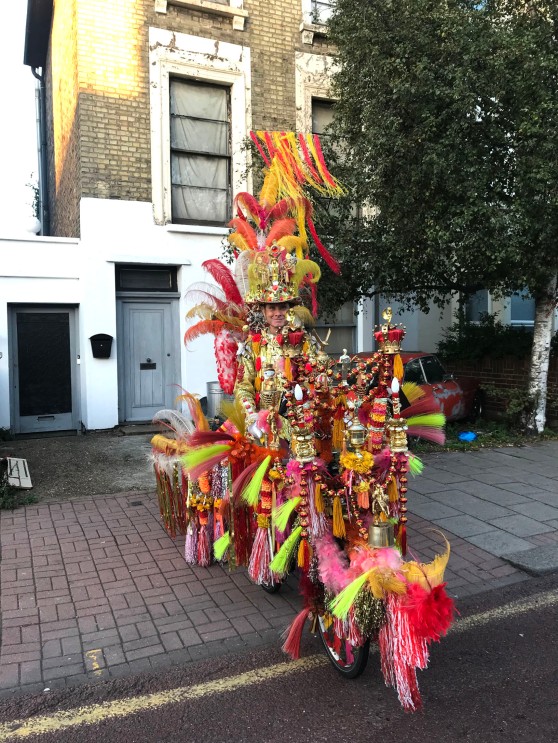
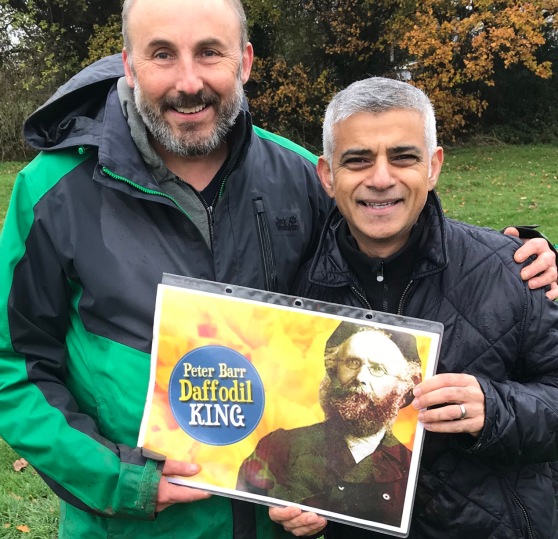

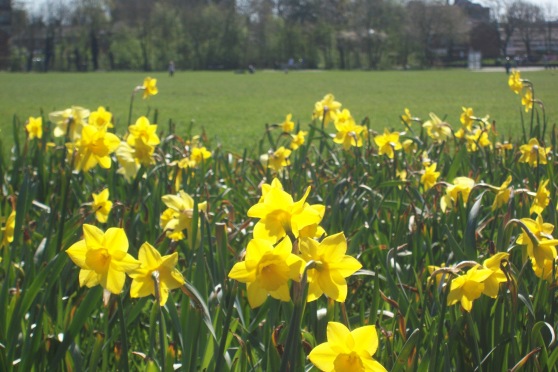
Its formally known as a Narcissus, sometimes apparently in days gone by, as the Lent Lily, but to people the world over, it is the much-loved Daffodil, a symbol of spring awakening, of good works, rebirth, care and charity, an optimistic harbinger of better times ahead. Its such a universal and popular flower that we hardly notice it. What a thrill then to find out that this ubiquitous yellow bloom has a very special historic connection to the place where we live. I was first introduced to Peter Barr and the extraordinary daffodil heritage he bequeathed to this area about five years ago by George Dear. If Peter Barr is the Daffodil King, George is his Tooting Kingmaker. Peter Barr was active here from about 1868 to 1889 when his nurseries and plant houses flourished alongside those of the Rollisson family on the land to the north of Tooting High Street. Its now covered by Broadwater School, St Augustine’s Church, Streatham Cemetery and extensive housing on both sides of Garratt Lane. Truly the scent of daffodils and the other plants and flowers once extensively grown here hangs heavily over this area.
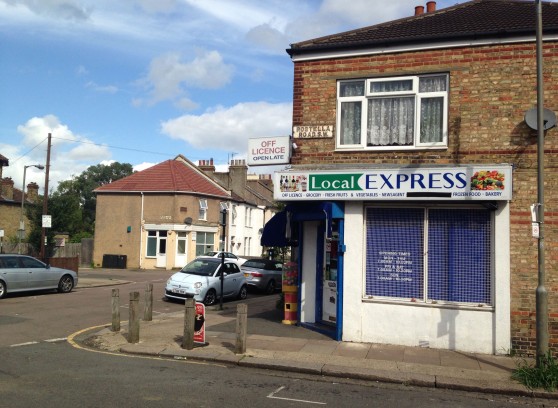

Quite literally in fact, as one of the roads, Rostella gets its name from part of an orchid, no less. Its an extraordinary legacy which was perpetuated for many decades with young people at Smallwood School being presented with bulbs up until the 1960s, the best ones receiving certificates in recognition of their daffodil-growing prowess. A few years ago we commemorated William Mace a ‘Forgotten First World War Soldier’ with a ceremony in Streatham Cemetery. This involved children hanging handmade daffodil tributes in a tree close to his grave. A century and a half after he alighted in Garratt Lane, now is surely the time to honour Peter Barr, the man who swathed the Tooting fields with yellow and travelled the world to return the daffodil to its position as one of the nation’s favourite flowers.

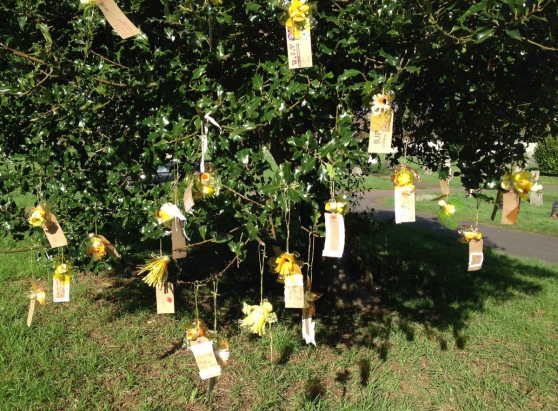

George was born in Pevensey Road, right in the very heart of all this history. One of his earliest memories being the V2 bomb in nearby Hazelhurst Road. He has had a lifelong interest in plants and gardening and worked for many years as a groundsman for Wandsworth Council. About twenty years ago he became curious about Peter Barr after reading in ‘The International Daffodil Checklist’ that in 1886 he had a nursery in Tooting. Retirement allowed George to take on an extensive research project. It was so much harder in those pre-internet days but George came up with some invaluable local connections which allow us today to acknowledge and celebrate The Daffodil King and his work in Tooting. With the daffodil fields and nurseries long gone and leaving no trace, old documents showed that Peter Barr was resident at at least two locations which still stand. Some of the oldest buildings in the area, these prominent three-storey townhouses are just a stone’s throw from bustling Tooting Broadway, the last grand buildings on the great Garratt Lane road connecting Wandsworth and Tooting. Census records and street directories tell us that between 1870 and 1876, numbers 1073 and 1065 Garratt Lane, once 10 and 18 New Road were home to Peter Barr and his thriving family. The 1871 census lists his wife Martha and seven children, four girls and three boys, aged between ten and three.



Ten years later the 1881 census sees them living at Bell Farm, a location indicated on many maps opposite Streatham Cemetery, roughly where an early seventies block Copeland House stands today. The fields attached to this would have been the location of present-day Pevensey Road, Smallwood Road and Thurso Street. George Dear concluded that his grandfather and great grandfather, both living in the area and working as agricultural labourers, would very likely have known, possibly even worked for The Daffodil King.
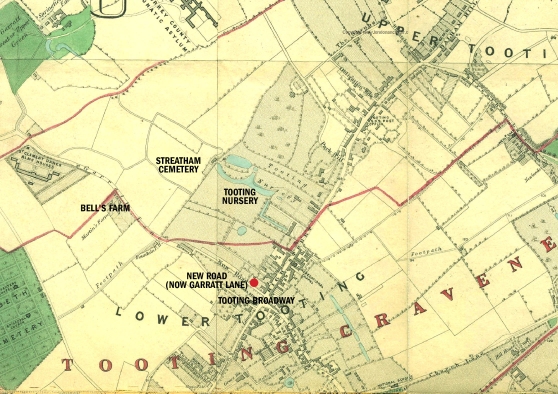
The above map dates from 1863, just a few years before Peter Barr came to Tooting. The Tooting Nursery is clearly marked in the area that is now Hebdon Road. Very obvious on this map are the old manorial water features which lent their name to present day Fishponds Road. Adjoining this were fields which thirty years later became Streatham Cemetery. Peter Barr and his family lived first at 6 New Road and later at 18 and 10 New Road. These houses were built in 1868 and he was one of the first residents. This final section of Garratt Lane, stretching two and a half miles from Wandsworth, became Defoe Road and from 1938 the name was extended to Tooting Broadway. The name chances and re-numberting have made the present day locations of the houses on New Road hard to identify but one local family who have lived in the area since before the Second World War kindly showed us the original deeds. By 1878 the Barrs had moved a short distance up the road to Smallwood Farm, later Bell Farm, not far from the St Clement Danes Almshouses. On this map it is indicated as Martin’s Farm, owned at that stage by the widow of Samuel Martin.
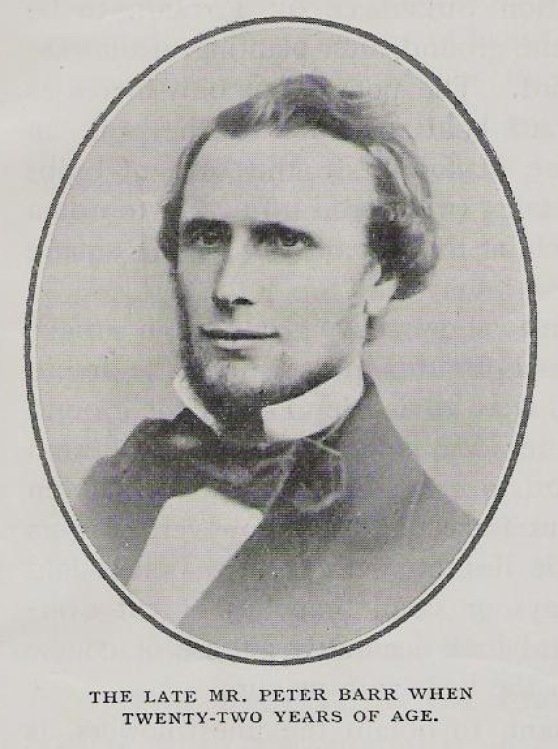
Peter Barr was born one of twelve brothers in Govan, Glasgow in 1826, the son of a weaver. His father was an avid grower of tulips and young Peter took an interest and got a job as an errand boy in a seed shop. He worked his way up to manager and eventually ended up in London, settling in the Islington area where he married Martha Hewlings from Spalding, Lincolnshire in 1859.
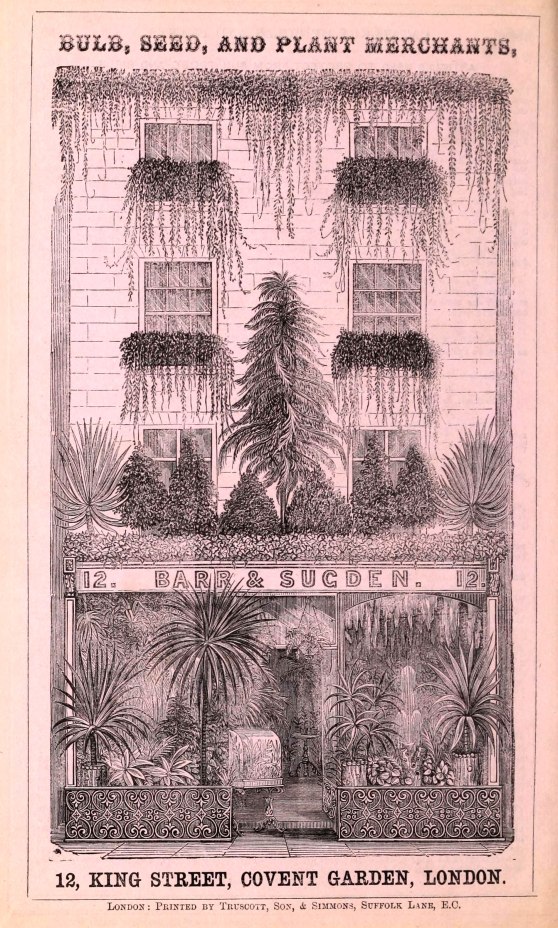


From about 1861, Peter Barr was a partner in a seed and garden shop ‘Barr and Sugden’ in Covent Garden. Right at the heart of London’s premier fruit, vegetable and flower market, the original building is still there at 12 King Street, just around the corner from the Royal Opera House, appropriately opposite the Petersham Nurseries emporium. The firm expanded from a florists into a general business dealing in seeds and plants. The Barrs were back at this address in the 1891 census so this was quite a lengthy tenure. Daffodils re-introduced from Spain were a mainstay but the firm also specialised in iris, tulips and lilies. Needing somewhere to cultivate their produce, Peter looked to the under-developed area to the south west of the city. The grounds at Lower Tooting, in the fertile Wandle Valley were a proven growing area. Rustic Tooting was also a splendid place to raise a young family away from the creeping industrialisation of the big city. Since the last years of the eighteenth century the Rollison family had established their own nurseries here. At their height they employed some fifty plantsmen and were famed for their cultivation of orchids, rhodedendrons, ferns, ‘the best collection of heaths in the London area’ and ‘the finest show house in the trade’. They used the water features which were once the moats of the Tooting manor house to grow aquatic plants. They were patronised by aristocracy and were a favourite stop for Sir Joseph Paxton looking to stock up on greenery for Chiswick House and the Crystal Palace. Before this the rich Wandle alluvium had attracted Huguenot market gardeners, fleeing from religious persecution in France and Belgium.

Peter Barr would most certainly have come into contact with a woman called Eliza Jane Bell of Park Hill House, whose extensive grounds would have overlooked the nurseries. A wealthy philanthropic recluse known as ‘Lady Bountiful’. Her father Alexander had made a fortune selling corn to the government during the Crimean War. She was extremely religious and when her father died in 1886 leaving her £350,000 she declared ‘I am very rich, I know, but God shall have it all’. It was very likely that Bell Farm where the Barrs lived in 1881 was part of the family estate and named after them.

By the mid-1800s daffodils were decidedly out of fashion, regarded as wild flowers, unfit for gardens with a status akin to something like a dandelion today. Yellow was for some reason not a popular colour in this early Victorian age. Peter Barr had read in a catalogue written in 1629 called ‘Paradisus Terrestris’ that 94 varieties of the flower had been grown in British gardens in the early 1600s. He set out on a mission to being them back to life. A key early move was the purchase of the uncategorised collections of two famous breeders, Mr Backhouse and Mr Leeds, after their deaths. He then launched himself on a global journey, travelling the world in search of bulbs to bring back to London. His standard book ‘Ye Narcissus, or Daffodyl Flower and Hys Roots’ was published in 1884, probably after many late nights of writing in New Road and Bell Farm.
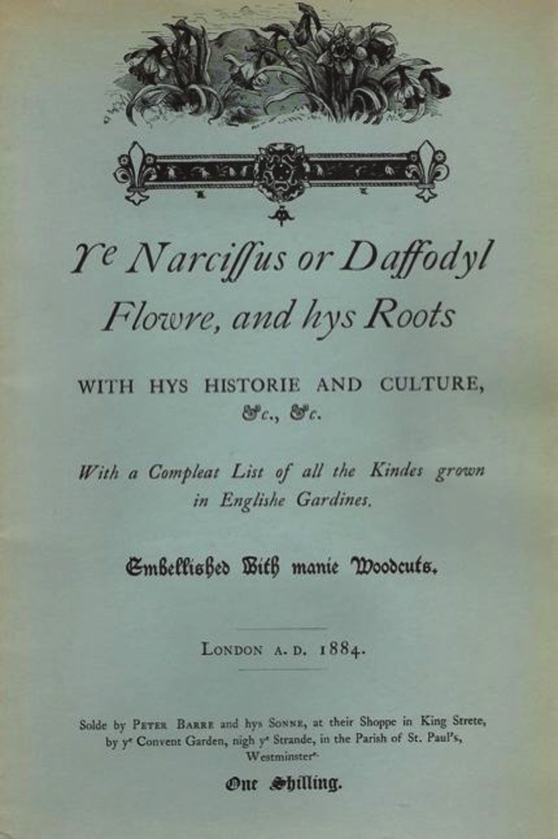
Sadly Martha Barr died in 1882 aged 51 which possibly precipitated a move and even more travelling. By 1891 Peter Barr had relocated his business to Thames Ditton. Back in Tooting, both the farm and the exotic nursery had been sold and a network of houses and streets were emerging. Streatham Cemetery opened for business in 1892. ‘Exotic Villas’ at the lower end of Fountain Road would be the only legacy of all the horticultural activity. Soon the Fairlight area would be completely built over as families like those of Sadie Crawford, Tiny Ted Foster and Sidney Lewis populated the area. George Dear discovered that the main Bell Farm house and yard were occupied by a builder from Liskeard in Cornwall called William Bond who used it as a base for the construction of the nearby streets.
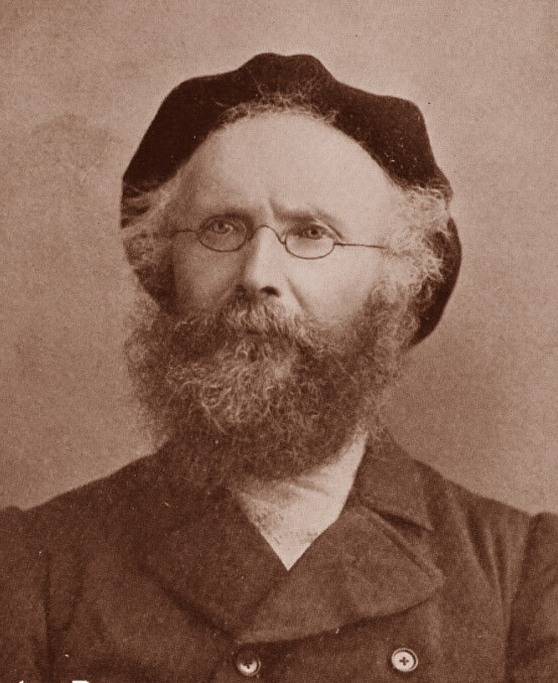
Aged 73, at the turn of the century, the indefatigable Peter Barr set out on a world tour that lasted seven years. His search for new or forgotten varieties of daffodil took him all over the world – to China, Japan, South America and Australia. In Melbourne it was reported ‘Although over 70 years of age, he is a keen observer, with a remarkably retentive memory, and is much more active than many men 20 years his junior. As he strolls about in a garden he will tell you the family history of each flower or plant that catches the eye. Under his guidance the hidden beauties of plant life unfold themselves in such numbers that the dilettante flower-lover feels utterly abashed. No one can realise how a man can love a flower until he has seen Mr. Barr take a bloom in his hand, and turn its face towards his own. The innocent delight in his eyes, the gentleness and fond delicacy of his touch, are good to see’. On one trip through Spain he climbed alone to the top of a 7000 foot mountain where he found a daffodil which had not been cultivated for 250 years. His work was highly acclaimed and in 1897 Peter Barr was one of the first recipients of the Royal Horticultural Society’s Victoria Medal of Honour. In 1912, three years after his death, The Royal Horticultural Society established the Peter Barr Memorial Cup, still awarded annually to those who have done great work in the service of daffodils. One of the early recipients was his son Peter Rudolph Barr.

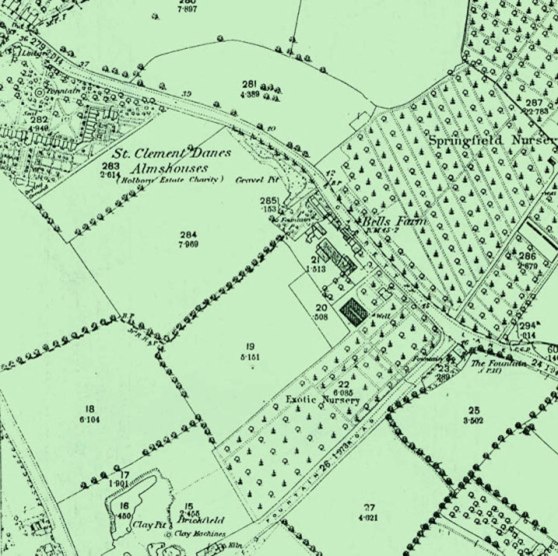
Back to the 1870s and Peter Barr’s various family homes. Almost 150 years after they lived there, this seems like the right time and an appropriate location for a publicly funded heritage plaque acknowledging his work in this area. An extraordinary map from 1871 shows the location of Bell Farm in the middle of what looks like a forest covering both sides of Garratt Lane, over what is now Streatham Cemetery and Copeland House. The area to the north of Fountain Road is clearly indicated as ‘Exotic Nursery’ and ‘Springfield Nursery’ is on the opposite side. On other maps of the time it is referred to as ‘American Nursery’. Quite fitting then, that there is a tablet commemorating ‘England’s Greatest Horticulturalist’ in a place called Paw Paw, half way between Detroit and Chicago.



Peter Barr’s family home on Garratt Lane is at a key location, on one of the busiest roads in south London, just a short walk from Tooting Broadway tube station. It is passed each day by thousands of people, who when we put up a plaque will learn about the Daffodil King and our area’s part in the evolution of this beautiful yellow flower. Its the very least we can do for a man renowned the world over – ‘The Daffodil King’ or ‘Peter the Great’. Look out for a grand unveiling event in September and in the meantime, if you’d like to contribute to another historic plaque in this area, come on one of our Guided Walks and make a donation. We’ll be outlining some dates very soon but it seems appropriate to do one when the daffs are next in all their glory, so look out for ‘Blooming Tooting’ on Saturday 16th March. It starts outside Tooting Broadway at 2pm – meet there for an entertaining and informative two hour tour of the world of The Daffodil King. We also hoping to involve local schools in this initiative – Broadwater Primary, whose school is on a site that would have been bang in the middle of all this horticultural activity have heard all about him on their History Walks. Ernest Bevin College History Club are helping us update our research. A former pupil there is Sadiq Khan, the Mayor of London. Another Garratt Lane boy, he was thrilled to hear about The Daffodil King when I bumped into him at a tree-planting event just before Christmas.

Thanks to George Dear and John Brown for their research into Peter Barr, also these two excellent accounts of his life and times.
https://gardenmoxie.com/2018/04/peter-barr-daffodil-king/
https://studiedmonuments.wordpress.com/2015/03/11/peter-barr-the-daffodil-king/